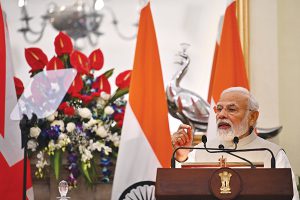Call it poor judgment or bad luck, but India’s expansion of natural gas coverage to more than 90% of its population couldn’t have come at a worse time. In January, Adani Total Gas Ltd and others won keenly contested licenses to add new areas to city gas networks; in February, Vladimir Putin invaded Ukraine. Suddenly, billions of dollars in investment are on shaky ground.
After an extraordinary surge last month, European spot prices of natural gas are stabilising — at three times the average of the past decade. Contracted supplies of liquefied natural gas are cheaper, but with Europe scrambling to secure non-Russian fuel, the discount is shrinking, according to a Bloomberg News report. Worse still, it’s unlikely to be a blip: Credit Suisse Group AG predicts that the Russian gas deficit will lead to an annual global LNG shortage of nearly 100 million tons by the middle of the decade.
This isn’t what New Delhi anticipated when it decided to raise the share of natural gas in India’s energy mix to 15% by 2030 from under 7% now, as part of a plan to improve air quality.
India had nine of the world’s 10 most polluted cities in 2020. Natural gas doesn’t eliminate carbon emissions, but it’s an improvement over diesel. It’s something to hold the fort until better options — such as green hydrogen — become affordable for emerging markets.
The environment, however, isn’t the only reason Prime Minister Narendra Modi has given a massive push to city gas projects. The move also has political significance. Piped natural gas, or PNG, delivered to urban homes relieves the demand pressure on liquefied petroleum gas, or LPG, cylinders. Those can then be pushed to rural areas where the government has helped poor families open 90 million new LPG accounts to help them migrate from burning wood, coal, dung-cake or kerosene to using cleaner cooking gas. The campaign buttressed Modi’s popularity with women voters, which is why the 2016 program saw a jump in enrollment before his successful 2019 reelection bid.
But the economics of PNG — and CNG, compressed natural gas supplied to motorists as an alternative to gasoline and diesel — is wobbly. State-run Oil & Natural Gas Corp. and Oil India Ltd. produce gas domestically, as does Reliance Industries Ltd. in partnership with BP Plc. Under a complex pricing formula, this output is allocated to city gas and fertiliser firms, the two biggest users, as well as power stations and LPG plants.
The prices are artificial. Until last month, the government kept the administered gas price at $2.9 per million British thermal unit — hardly enough for the producers to make much money. The gas extracted from difficult deep-sea Indian fields was allowed to be priced at $6.1 per million Btu. Compare that with what the market is charging: The June delivery contract of the Japan-Korea marker, an Asian benchmark, shot past $50 per million Btu in March, and is currently at about half that level.
The cheap pricing provided just-as-artificial legs to demand. The Indian government enthusiastically declared two years ago that $66 billion in investments were lined up into everything from pipelines to city gas infrastructure and LNG regasification terminals.
The trouble is with supply. It petered out a decade ago after Reliance’s gas discovery off India’s eastern coast turned out to be less bountiful than originally expected. Since local production never responded to the government’s complicated pricing signal, industries paid $8 to $10 per million Btu for imported LNG in addition to their domestic gas quotas. That was before the war.
Now that imported cargo costs a lot more, there’s great hunger for the local stuff, especially in the city gas industry that has grown breathlessly with the government’s encouragement.
There’s an added complexity. Setting aside more for city use means giving the fertiliser industry less, forcing it to pay a higher blended price to make the nitrogen-rich products that go into India’s agricultural land. That boomerangs on the taxpayer because the farmer’s cost of urea is also subsidised: Each $1 increase in the gas feedstock price for fertiliser hits New Delhi’s budget calculations by roughly $600 million. As global food shortages intensify, the only hope for India is that its farmers would feed the country with blowout harvests. Fertilisers can’t be trifled with.
The economies of urban gas supply will get messier still. India this month raised the administered domestic price from $2.9 to $6.1 per million Btu. City gas distributors will readily take that because LNG imports are much more expensive, but the government is holding down the supply at March 2021 levels.
—Bloomberg
Andy Mukherjee is a Bloomberg Opinion columnist covering industrial companies and financial services. He previously was a columnist for Reuters Breakingviews. He has also worked for the Straits Times, ET NOW and Bloomberg News
 The Gulf Time Newspaper One of the finest business newspapers in the UAE brought to you by our professional writers and editors.
The Gulf Time Newspaper One of the finest business newspapers in the UAE brought to you by our professional writers and editors.

